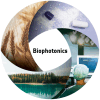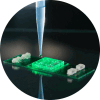Shining a Light on the Future of Biophotonics
- PMID: 40364668
- PMCID: PMC12245495
- DOI: 10.1002/jbio.202500148
Shining a Light on the Future of Biophotonics
Abstract
Biophotonics-the interdisciplinary fusion of light-based technologies with biology and medicine-is rapidly transforming research, diagnostics, and therapy across various domains. This white paper, developed in conjunction with the International Congress on Biophotonics 2024, offers a comprehensive overview of the current landscape and future potential of biophotonics. It discusses core technologies such as bioimaging, biosensing, and photonic-based therapies, while highlighting novel applications in oncology, infectious diseases, neurology, cardiovascular health, agriculture, food safety, and environmental monitoring. The document also explores key enablers, including artificial intelligence, novel materials, and quantum biophotonics, along with critical challenges related to standardization, regulation, and clinical translation. A SWOT analysis and recommendations are provided to guide future research, commercialization, and interdisciplinary collaboration, underscoring biophotonics as a cornerstone of next-generation precision medicine and the One Health approach.
Keywords: artificial intelligence; bioimaging; biophotonics; biosensing; clinical translation; laser medicine; one health; optical health technologies; photonic therapy.
© 2025 The Author(s). Journal of Biophotonics published by Wiley‐VCH GmbH.
Conflict of interest statement
The authors declare no conflicts of interest.
Figures







References
-
- Popp J., Tuchin V. V., Chiou A., and Heinemann S. H., Handbook of Biophotonics, Volume 1: Basics and Techniques (Wiley, 2011).
-
- Popp J., Tuchin V. V., Chiou A., and Heinemann S. H., Handbook of Biophotonics: Volume 2: Photonics for Health Care (Wiley, 2011).
-
- Popp J., Tuchin V. V., Chiou A., and Heinemann S. H., Handbook of Biophotonics, Volume 3: Photonics in Pharmaceutics, Bioanalysis and Environmental Research (Wiley, 2012).
-
- Vo‐Dinh T., Biomedical Photonics Handbook: Therapeutics and Advanced Biophotonics (2nd ed, Taylor & Francis, 2014).
-
- Meglinski I., Biophotonics for Medical Applications (Woodhead Publishing, 2015).
Publication types
MeSH terms
LinkOut - more resources
Full Text Sources

